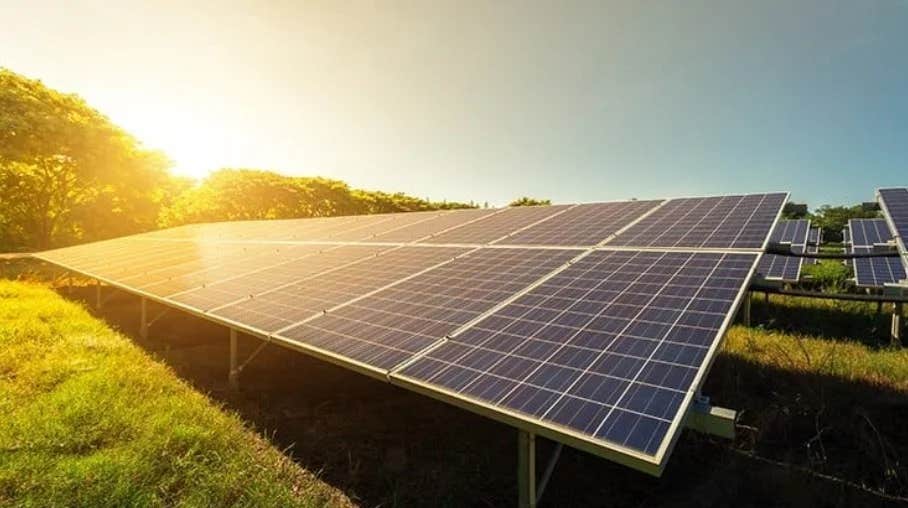Breakthrough in clean energy: New solar energy system generates power 24 hours a day
Finding more efficient ways to harness solar energy is critical to transitioning to a carbon-free electric grid.

Researchers developed a new type of solar energy harvesting system that breaks the efficiency record of all existing technologies. (CREDIT: Creative Commons)
The great inventor Thomas Edison once said, “So long as the sun shines, man will be able to develop power in abundance.” This idea of harnessing solar energy has captivated inventors for centuries. Photovoltaic cells, which convert sunlight directly into energy, have made significant advancements. However, the generation of solar power remains limited to daytime hours.
You’ll find the historic quest for efficient solar energy continues at the University of Houston. A professor there reports on a groundbreaking solar energy harvesting system that surpasses the efficiency record of all existing technologies and allows for the use of solar power around the clock.
"With our architecture, the solar energy harvesting efficiency can be improved to the thermodynamic limit,” reports Bo Zhao, Kalsi Assistant Professor of mechanical engineering, alongside his doctoral student Sina Jafari Ghalekohneh in the journal Physical Review Applied. The thermodynamic limit is the absolute maximum theoretically possible conversion efficiency of sunlight into electricity.
Transitioning to a carbon-free electric grid requires more efficient ways to harness solar energy. According to a recent study by the U.S. Department of Energy Solar Energy Technologies Office and the National Renewable Energy Laboratory, solar could account for as much as 40% of the nation’s electricity supply by 2035 and 45% by 2050, pending aggressive cost reductions, supportive policies, and large-scale electrification.
Thermophotovoltaics and the blackbody limit
Traditional solar thermophotovoltaics (STPV) use an intermediate layer to improve efficiency. This layer, facing the sun, absorbs all incoming photons, converting solar energy to thermal energy and raising its temperature. Despite these advancements, the thermodynamic efficiency limit of STPVs has been stuck at the blackbody limit (85.4%), much lower than the ultimate Landsberg limit (93.3%).
The blackbody limit, also known as the blackbody radiation limit or the Planck limit, refers to the maximum amount of thermal radiation that can be emitted by a blackbody, an idealized physical body that absorbs all incident electromagnetic radiation and re-emits it perfectly at every wavelength. This concept is rooted in Planck's law of blackbody radiation, which describes the spectral density of electromagnetic radiation emitted by a blackbody in thermal equilibrium at a given temperature.
The blackbody limit is significant in various fields, including astrophysics, climate science, and material science, as it sets a theoretical upper bound on the thermal radiation that any object can emit. It is used to model the radiation properties of stars, planets, and other celestial bodies, as well as in the design of thermal radiation detectors and emitters.
Zhao explains, “The efficiency deficit is caused by the inevitable back emission of the intermediate layer towards the sun due to the reciprocity of the system. We propose nonreciprocal STPV systems with an intermediate layer that has nonreciprocal radiative properties. This layer can significantly reduce its back emission to the sun and direct more photon flux towards the cell."
With this improvement, the nonreciprocal STPV system can achieve the Landsberg limit. Practical STPV systems with single-junction photovoltaic cells can also experience a significant efficiency boost.
Besides improved efficiency, STPVs offer compactness and dispatchability—electricity that can be programmed on demand based on market needs.
In practical applications, STPVs can be combined with an economical thermal energy storage unit to generate electricity 24/7. The NSTPV system developed by researchers reaches the Landsberg limit, and practical NSTPV systems with single-junction photovoltaic cells also see a significant efficiency increase.
“Our work highlights the great potential of nonreciprocal thermal photonic components in energy applications,” says Zhao. “The proposed system offers a new pathway to significantly improve the performance of STPV systems. It may pave the way for implementing nonreciprocal systems in practical STPV systems currently used in power plants."
Note: Materials provided above by the The Brighter Side of News. Content may be edited for style and length.
Like these kind of feel good stories? Get the Brighter Side of News' newsletter.
Joseph Shavit
Head Science News Writer | Communicating Innovation & Discovery
Based in Los Angeles, Joseph Shavit is an accomplished science journalist, head science news writer and co-founder at The Brighter Side of News, where he translates cutting-edge discoveries into compelling stories for a broad audience. With a strong background spanning science, business, product management, media leadership, and entrepreneurship, Joseph brings a unique perspective to science communication. His expertise allows him to uncover the intersection of technological advancements and market potential, shedding light on how groundbreaking research evolves into transformative products and industries.



